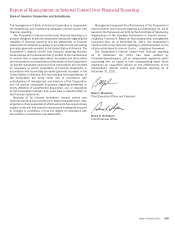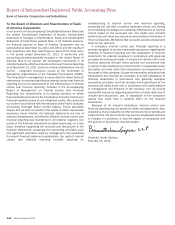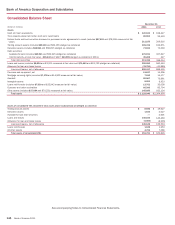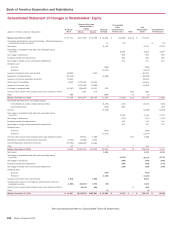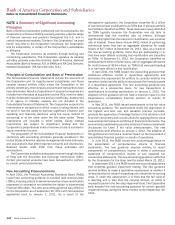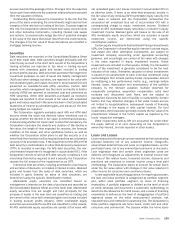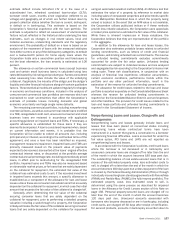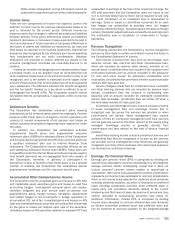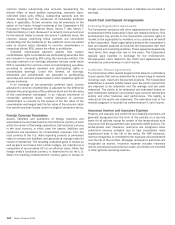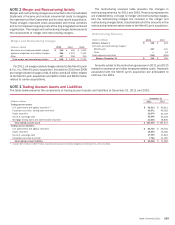Bank of America 2011 Annual Report Download - page 157
Download and view the complete annual report
Please find page 157 of the 2011 Bank of America annual report below. You can navigate through the pages in the report by either clicking on the pages listed below, or by using the keyword search tool below to find specific information within the annual report.Bank of America 2011 155
be exercised and the passage of time. Changes from the expected
future cash flows related to the customer relationship are excluded
from the valuation of IRLCs.
Outstanding IRLCs expose the Corporation to the risk that the
price of the loans underlying the commitments might decline from
inception of the rate lock to funding of the loan. To protect against
this risk, the Corporation utilizes forward loan sales commitments
and other derivative instruments, including interest rate swaps
and options, to economically hedge the risk of potential changes
in the value of the loans that would result from the commitments.
The changes in the fair value of these derivatives are recorded in
mortgage banking income.
Securities
Debt securities are recorded on the Consolidated Balance Sheet
as of their trade date. Debt securities bought principally with the
intent to buy and sell in the short term as part of the Corporation’s
trading activities are reported at fair value in trading account
assets with unrealized gains and losses included in trading
account profits (losses). Debt securities purchased for longer term
investment purposes, as part of asset and liability management
(ALM) and other strategic activities, are reported at fair value with
net unrealized gains and losses included in accumulated OCI and
presented as available-for-sale (AFS) securities. Certain debt
securities which management has the intent and ability to hold to
maturity (HTM) are reported at amortized cost and presented as
HTM securities. Other debt securities purchased as economic
hedges are reported in other assets at fair value with unrealized
gains and losses reported in the same line item in the Consolidated
Statement of Income as unrealized gains and losses on the item
being hedged are reported.
The Corporation regularly evaluates each AFS and HTM debt
security where the value has declined below amortized cost to
assess whether the decline in fair value is other-than-temporary.
In determining whether an impairment is other-than-temporary, the
Corporation considers the severity and duration of the decline in
fair value, the length of time expected for recovery, the financial
condition of the issuer, and other qualitative factors, as well as
whether the Corporation either plans to sell the security or it is
more-likely-than-not that it will be required to sell the security before
recovery of its amortized cost. If the impairment of the AFS or HTM
debt security is credit-related, an other-than-temporary impairment
(OTTI) is recorded in earnings. For AFS debt securities, the non-
credit-related impairment is recognized in accumulated OCI. If the
Corporation intends to sell an AFS debt security or believes it will
more-likely-than-not be required to sell a security, the Corporation
records the full amount of the impairment as an OTTI.
Interest on debt securities, including amortization of premiums
and accretion of discounts, is included in interest income. Realized
gains and losses from the sales of debt securities, which are
included in gains (losses) on sales of debt securities, are
determined using the specific identification method.
Marketable equity securities are classified based on
management’s intention on the date of purchase and recorded on
the Consolidated Balance Sheet as of the trade date. Marketable
equity securities that are bought and held principally for the
purpose of resale in the near term are classified as trading and
are carried at fair value with unrealized gains and losses included
in trading account profits (losses). Other marketable equity
securities are accounted for as AFS and classified in other assets.
All AFS marketable equity securities are carried at fair value with
net unrealized gains and losses included in accumulated OCI on
an after-tax basis. If there is an other-than-temporary decline in
the fair value of any individual AFS marketable equity security, the
cost basis is reduced and the Corporation reclassifies the
associated net unrealized loss out of accumulated OCI with a
corresponding charge to equity investment income. Dividend
income on AFS marketable equity securities is included in equity
investment income. Realized gains and losses on the sale of all
AFS marketable equity securities, which are recorded in equity
investment income, are determined using the specific
identification method.
Certain equity investments held by Global Principal Investments
(GPI), the Corporation’s diversified equity investor in private equity,
real estate and other alternative investments, are subject to
investment company accounting under applicable accounting
guidance, and accordingly, are carried at fair value with changes
in fair value reported in equity investment income. These
investments are included in other assets. Initially, the transaction
price of the investment is generally considered to be the best
indicator of fair value. Thereafter, valuation of direct investments
is based on an assessment of each individual investment using
methodologies that include publicly-traded comparables derived
by multiplying a key performance metric (e.g., earnings before
interest, taxes, depreciation and amortization) of the portfolio
company by the relevant valuation multiple observed for
comparable companies, acquisition comparables, entry level
multiples and discounted cash flows, and are subject to
appropriate discounts for lack of liquidity or marketability. Certain
factors that may influence changes in fair value include but are
not limited to recapitalizations, subsequent rounds of financing
and offerings in the equity or debt capital markets. For fund
investments, the Corporation generally records the fair value of its
proportionate interest in the fund’s capital as reported by the
funds’ respective managers.
Other investments held by GPI are accounted for under either
the equity method or at cost, depending on the Corporation’s
ownership interest, and are reported in other assets.
Loans and Leases
Loans measured at historical cost are reported at their outstanding
principal balances net of any unearned income, charge-offs,
unamortized deferred fees and costs on originated loans, and for
purchased loans, net of any unamortized premiums or discounts.
Loan origination fees and certain direct origination costs are
deferred and recognized as adjustments to interest income over
the lives of the related loans. Unearned income, discounts and
premiums are amortized to interest income using a level yield
methodology. The Corporation elects to account for certain loans
under the fair value option with changes in fair value reported in
other income for consumer and commercial loans.
Under applicable accounting guidance, for reporting purposes,
the loan and lease portfolio is categorized by portfolio segment
and, within each portfolio segment, by class of financing
receivables. A portfolio segment is defined as the level at which
an entity develops and documents a systematic methodology to
determine the allowance for credit losses, and a class of financing
receivables is defined as the level of disaggregation of portfolio
segments based on the initial measurement attribute, risk
characteristics and methods for assessing risk. The Corporation’s
three portfolio segments are home loans, credit card and other
consumer, and commercial. The classes within the home loans


